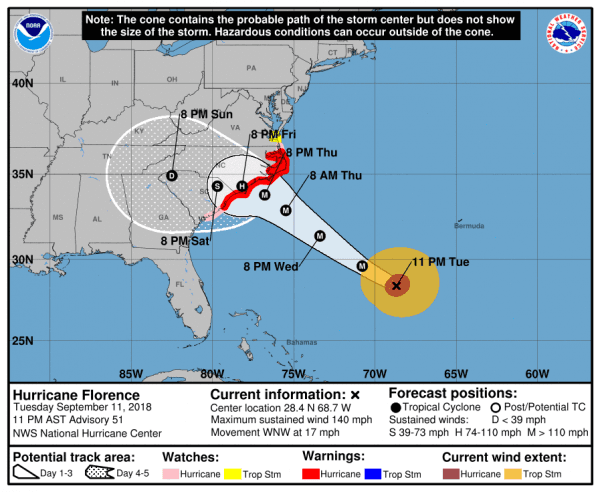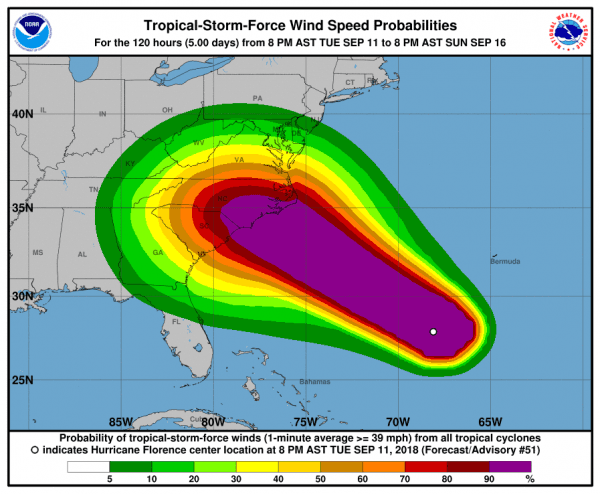The U.S. National Hurricane Center (NHC) has issued additional storm surge warnings in its latest Hurricane Florence update at 11 p.m. on Sept. 11.
Life-threntening storm surge warnings are now in effect for the entire North Carolina coast and parts of South Carolina—from Edisto Beach, South Carolina, all the way up the North Carolina coast through to the North Carolina/Virginia border. Albemarle and Pamlico Sounds, and the Neuse and Pamlico Rivers received special mention in the storm surge warning as Hurricane Florence continues to barrel towards to U.S. mainland. The Category 4 storm system is now bigger than the size of Michigan state.
In the 11 p.m. update, hurricane warnings remain in place for portions of South Carolina and North Carolina due to Hurricane Florence.
The tropical storm warning for north of the North Carolina-Virginia border to Cape Charles Light, Virginia, and the Chesapeake Bay south of New Point Comfort also remains in effect.
The update also warned of catastrophic flash flooding and river flooding, as forecast are predicting up to 3 feet of rainfall near the storm’s track over portions of the Carolinas and mid-atlantic states.

Motorists streamed inland on highways converted to one-way evacuation routes on Sept. 11 as about 1.7 million people in three states were warned to get out of the way of Hurricane Florence, a hair-raising storm taking dead aim at the Carolinas with 140 mph winds and the potentially ruinous rains.
Florence was expected to blow ashore late Thursday or early Friday, then slow down and wring itself out for days. The ‘biblical’ rainfall on the coast could cause flooding well inland and wreak environmental havoc by washing over industrial waste sites and hog farms.
Forecasters and politicians pleaded with the public to take the warnings seriously and minced no words in describing the threat.
“This storm is a monster. It’s big and it’s vicious. It is an extremely dangerous, life-threatening, historic hurricane,” North Carolina Gov. Roy Cooper said.
He added: “The waves and the wind this storm may bring is nothing like you’ve ever seen. Even if you’ve ridden out storms before, this one is different. Don’t bet your life on riding out a monster.”
More than 5.4 million people live in areas under hurricane warnings or watches on the U.S. East Coast, according to the National Weather Service, and another 4 million people were under a tropical storm watch.
President Donald Trump declared states of emergency for North and South Carolina and Virginia, opening the way for federal aid. He said the federal government is “absolutely, totally prepared” for Florence.
All three states ordered mass evacuations along the coast. But getting out of harm’s way could prove difficult.
Florence is so wide that a life-threatening storm surge was being pushed 300 miles ahead of its eye, and so wet that a swath from South Carolina to Ohio and Pennsylvania could get deluged.
People across the region rushed to buy bottled water and other supplies, board up their homes, pull their boats out of the water and get out of town.
At 11 p.m., the storm was centered 670 miles southeast of Cape Fear, North Carolina, moving at 17 mph. It was a potentially catastrophic Category 4 storm but was expected to keep drawing energy from the warm water and intensify to near Category 5, which means winds of 157 mph or higher.

Florence is the most dangerous of three tropical systems in the Atlantic. Tropical Storm Isaac was east of the Lesser Antilles and expected to pass south of Puerto Rico, Hispaniola and Cuba, while Hurricane Helene was moving northward away from land. Forecasters also were tracking two other disturbances.
The coastal surge from Florence could leave the eastern tip of North Carolina under more than 9 feet of water in spots, projections showed.
“This one really scares me,” National Hurricane Center Director Ken Graham said.
Federal officials begged residents to put together emergency kits and have a plan on where to go.
“This storm is going to knock out power days into weeks. It’s going to destroy infrastructure. It’s going to destroy homes,” said Jeff Byard, an official at the Federal Emergency Management Agency.
Forecasters said parts of North Carolina could get 20 inches of rain, if not more, with as much as 10 inches elsewhere in the state and in Virginia, parts of Maryland and Washington, D.C.
One trusted computer model, the European simulation, predicted more than 45 inches in parts of North Carolina. A year ago, people would have laughed off such a forecast, but the European model was accurate in predicting 60 inches for Hurricane Harvey in the Houston area, so “you start to wonder what these models know that we don’t,” University of Miami hurricane expert Brian McNoldy said.
Rain measured in feet is “looking likely,” he said.
Duke Energy spokesman Ryan Mosier said operators would begin shutting down nuclear plants at least two hours before hurricane-force winds arrive.
North Carolina’s governor issued what he called a first-of-its-kind mandatory evacuation order for North Carolina’s fragile barrier islands from one end of the coast to the other. Typically, local governments in North Carolina make the call on evacuations.
“We’ve seen nor'easters and we’ve seen hurricanes before,” Cooper said, “but this one is different.”





Friends Read Free